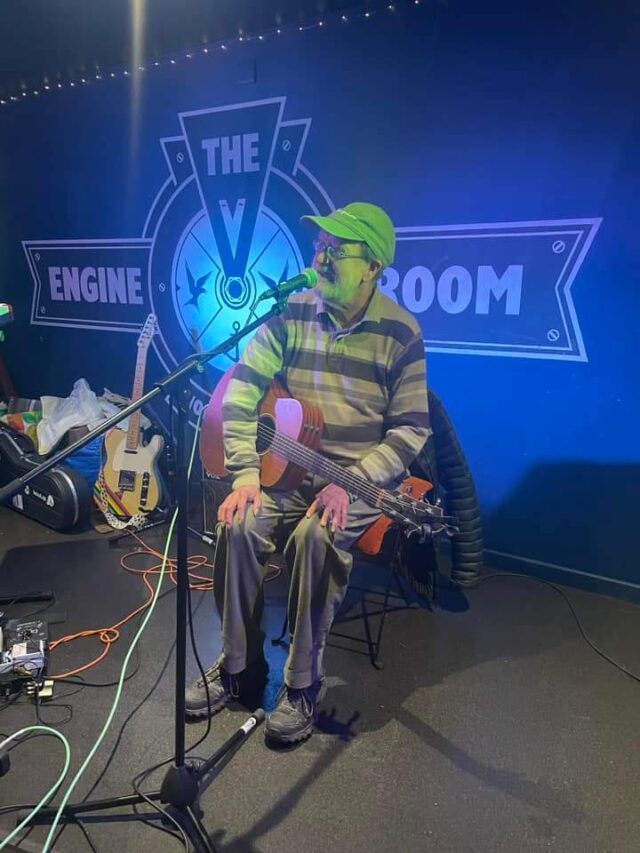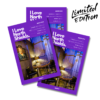A MUSICAL GALAPAGOS
Richard O’Brien interviews Nev Clay. Photo by JOAN HEWITT
As a child, Nev Clay recalls seeing North Shields as a ‘mystical place.’ Every Saturday, his family would take a diesel train from Benton to visit his paternal grandmother in Chirton Green. He remembers holding his breath through the series of three tunnels between the town and Tynemouth, ‘coming up for air’ in a ‘different realm’ where they would watch Doctor Who, play word games like Lexicon and marvel at a vitrified rock in the garden. Like much of Nev’s work, this story seems to overlay the ordinary with a sense of wonder, or perhaps to discover the wonder that was always there. It’s a quality that’s well in evidence on So Little Happened For So Long, his first album since 2001, released last month, and its centrepiece, ‘Cuddy’s Cave.’
It started life in the late 90s as a poem called ‘Last Exit’ which drew on the acerbic stylings of John Cooper Clarke. In 2013, Ashington musician Gary Lang asked if Nev had any lyrics to go over an instrumental, and the material evolved over time into a kind of regional litany, a string of rhyming couplets (some suggested by friends; all edited and organised by Nev) which bring together landmarks both historical and personal, from ‘The great Northumbrian coastal plain to Bargain Booze in Percy Main … from Cuddy’s Cave to me Grandma’s grave.’ Reflecting on the blend of tragedy and comedy that’s characteristic of his writing, Nev breaks down the three-frame structure of a Peanuts cartoon: ‘bathos, bathos, pathos.’
The lyric’s appearance in an illustrated poetry pamphlet from Lang’s Maplestreet Press has given Nev the opportunity to assess the evolution of the work, as an initial ‘harsh’ tribute to a rough area has ‘softened’ into something more ‘plangent’ and elegiac. Bereavement forms part of the backdrop: more broadly, Nev, a former NHS mental health nurse, sees the project through the lens of psychological reintegration. Early memories of North Shields (including, in a recent live version at the Engine Room which is excerpted on the previous page, ‘Xmas trees / On the Formica factory’) weave together with sites and references familiar across Northumberland, ‘Vindolanda to the Crown Posada.’
[tds_partial_locker tds_locker_id=”100″]These ‘vectors’ of connection speak to the magical ability of rhyme to put distant ideas in conversation. But their breadth also indicates a desire ‘to reconnect with Northumberland, with a deep past.’ This harks back to his 1960s childhood, a time before the creation of ‘Tyne & Wear’ as an artificial political entity: Nev affectionately remembers trips to the Mithraic Temple at Brocolitia and Lordenshaws hill-fort, whose ‘Neolithic ghosts’ have ‘haunted me ever since.’ Instead of clichéd visions of ‘whippets and flat caps,’ the song aims to explore the area’s past and present in all its complexity, in loving detail.
Specificity is the watchword of Nev’s writing style: he aims to write like ‘a CCTV camera,’ favouring ‘the recognisable world’ over the imagination. ‘It’s about eschewing the universal. I’m not interested in ‘We Are The World,’ you know what I mean?’ At gigs, he loves the charge of recognition when a local audience recognises a reference to Victory Amusements on Clayton Street, or the shuttered Lexus dealership in High Heaton, north of the Coast Road, which now provides a habitat for sparrows in the singer’s ‘favourite hedgerow.’ On a book rack in a toy shop in Forest Hall, he first discovered formative authors like Hemingway and the Mersey poets. Later, Mark E. Smith’s lyrics for The Fall were also a revelation: ‘Christ, you can write about anything.’
Musically, Nev has been on a circuitous journey. He taught himself guitar on a borrowed instrument which he tuned using the Rush song ‘Temple of Syrinx.’ With the top 40 on in the background on Sunday evenings, he’d play along to songs from ‘every genre,’ picking out the melodies and basslines. All this ‘farting around’ provided a comprehensive grounding, as did the character-based showtunes his mother, a keen amateur actor, would sing around the house. After some years shredding in a metal band, an injury in 1994 left Nev with his arm in a cast: looking for a different way to play, he discovered finger picking and, eventually, alternate tunings. ‘Every different tuning suggests different melodies,’ and the result is an intricate, complex and melodic playing style, closer at times to jazz than folk.
His work is also informed by a ‘millefiori’ of rich and diverse local music scenes to which he’s keen to give proper credit. This includes artists to whose recordings he’s contributed, like Lang’s project St James Infirmary and The Young Property Developers, but ‘it starts with promoters and venues, doesn’t it? Without them, there’s no scene.’ Nev lists key names like Slampt, who put on vibrant weekenders at the Cumberland Arms in the 90s, and Chris Trew, whose outfit Prancey Dog has become a record label to put out his new album.
‘There’s no money in it,’ he notes: the ‘selflessness’ of DIY scenes creates a ‘communal’ musical landscape where artists from different genres can meet and mingle easily, rather than fighting for opportunities ‘like rats in a sack’ as they might in bigger cities. He lands, instead, on a different animal metaphor: ‘It’s like a musical Galapagos, isn’t it – where things have just evolved at their own pace,’ and the finches ‘have developed these weird, twisted, specialised beaks for pecking these musical seeds from the surroundings.’ If Nev’s latest is anything to go, it’s been a rich harvest this year.
*
Nev Clay’s new album So Little Happened For So Long is now available at nevclay.bandcamp.com.

































